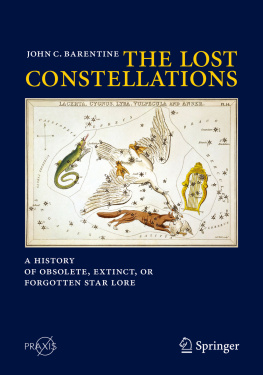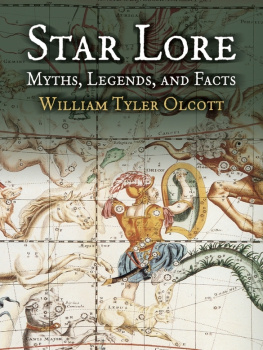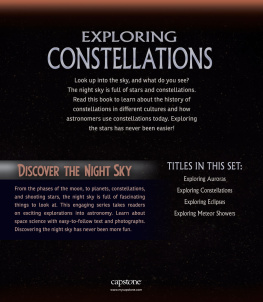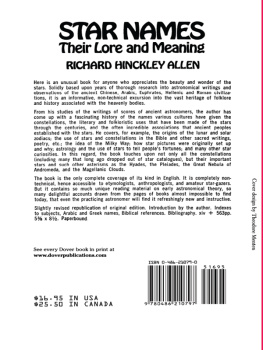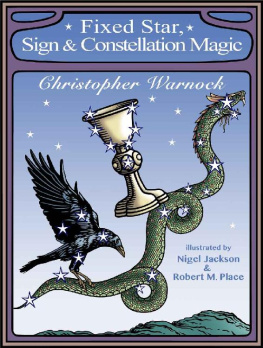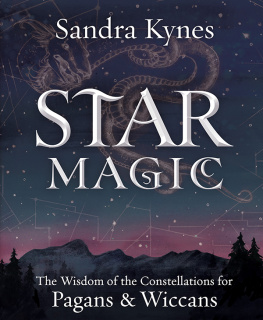1. What Is a Constellation?
[A]ncient customs are difficult to overcome, and it is very probable, that, except the recently-named groups, which we may now suppress, the venerable constellations will always reign.
Camille Flammarion, Astronomie Populaire (1880)
From a dark location on Earth, far from sources of artificial light pollution, a few thousand stars are sufficiently bright to be seen by the unaided human eye. They are spread across the night sky in a seemingly random way, although the keen observer will note a few structural consistencies. The sky is bisected by the path of the Milky Way, the faint band of light that represents the plane of the galaxy in which we live, its innumerable faint stars blurred together into softly glowing clouds as seen by the human eye. There are generally more visible stars in the direction of the Milky Ways center, in the constellation Sagittarius, than its anticenter (the point opposite the center on the sky) in the constellation Auriga. Otherwise, the distribution of stars visible to the naked eye does not yield many clues as to the Earths position in the universe.
One popular misconception about the stars is that brightness indicates distance, fainter stars being located further away from Earth than the bright ones; were it the case that all stars had identical intrinsic brightnesses, this would be true. But by the twentieth century, astronomers realized that the luminosities of stars spanned an enormous range of values, from those many thousands of times intrinsically brighter than the Sun to those just a fraction of a percent of our own stars luminosity. The brightness of stars, then, does not tell us much about the immediate volume of space we inhabit. That some stars are brighter and others are fainter is also only part of the story by which certain ones come to form recognizable patterns to humans.
The main influence on the distribution of stars in the night sky has to do with our location in (and the structure of) the Milky Way. Our home galaxy is a common type known a disk spiral, consisting of a relatively flat Disk embedded in an extended, more or less spherical Halo. A set of spiral arms, regions dense with stars and the materials from which they form, unwind from the center to the edge; the arms are not readily apparent in our night sky by virtue of the fact that the Solar System lies in their common plane. The central region of the Milky Way is characterized by a bar, a transient kinematic feature kicked up by resonant interactions between stars in their orbits and the gravitational potential of the entire galaxy. From our perspective, we see the bar oriented at an angle of about 45 to the line of sight toward the Galactic center, one end of the bar pitched toward to us and the other directed away.
Since we live inside the Disk, our understanding of the geometry of the Galaxy comes from the structures we can infer from our vantage point, supplemented by studies of other galaxies seen from the outside that we think resemble the Milky Way. Combining information from both sources, we can make an educated guess as to both the shape of our galaxy and the location of our solar system within it. An artists conception of the Milky Way is shown in Fig., illustrating what a viewer situated high above the plane of the Disk might see looking down at it. The Sun, whose position is marked by a yellow circle, makes a leisurely orbit around the Galactic center once every 225250 million years. Our motion through the Galaxy ensures that the Earths night sky is never static, and that the stars of tonights sky differ from those of the distant past and future.
Fig. 1.1
An artists rendering of the Milky Way as it might appear viewed face-on from several hundred thousand light years above the midplane. The solid white circle indicates the location of the Sun (Credit: NASA/JPL-Caltech/R. Hurt)
Early astronomers presumed the Solar System was located at the center of this system given two pieces of evidence. First, when we look out into the night sky we see stars in every direction, but they tend to be concentrated into a fairly narrow band dividing the sky into two halves. This suggests a largely flattened system, and that we must be situated nearly in its middle. Second, this band of stars is fairly uniform in density around the sky in an azimuthal sense, so we must be near or at the center of the flat disk. Studies carried out in the twentieth century showed that we are not at the center of the Galaxy, but rather at some considerable radius. In fact, the Suns place in the Milky Way is on a spur projecting from one of the spiral arms, a relatively quiet backwater compared to the swift streams of the main spiral arms and the crowded environment of the Galactic center.
Humanitys first view of the Milky Way as a single stellar system emerged in the eighteenth century. While the Galaxy has been known since time immemorial, an understanding of its composition awaited the invention of the telescope. In 1610 Galileo Galilei turned one to the Milky Way for the first time, resolving its luminous clouds into innumerable faint stars. A century later philosophers and scientists began to devise ideas about what the Galaxy physically represents. The English astronomer Thomas Wright published An original theory or new hypothesis of the Universe in 1750, in which he posited that the Milky Way was a large, rotating body composed of individual stars held together by gravity. He deduced it was a scaled-up version of the solar system, by then describable with relatively simple physics under Isaac Newtons universal theory of gravitation. In 1755, the German philosopher Immanuel Kant elaborated on Wrights hypothesis, suggesting that the Milky Way might have begun as a spinning cloud of gas that somehow condensed into stars. He further speculated that other similar systems might exist and that the faint and featureless nebulae seen in contemporary telescopes could be such island universes unto themselves.
Based on his careful telescopic counts of stars toward various directions in the night sky, the Anglo-German astronomer William Herschel made probably the first attempt at a structural model of the Milky Way (Fig.), correctly concluding that the solar system was embedded inside it. From this vantage point, Herschel wrote,
the heavens will not only be richly scattered over with brilliant constellations, but a shining zone or milky way will be perceived to surround the whole sphere of the heavens, owing to the combined light of those stars which are too small, that is, too remote to be seen. Our observers sight will be so confined, that he will imagine this single collection of stars, of which he does not even perceive the thousandth part, to be the whole contents of the heavens.
Fig. 1.2
William Herschels model of the Milky Way based on his star counts. The model is essentially a longitudinal slice through the Galaxy, reflecting the Solar Systems position within its Disk. Figure 4 from On the Construction of the Heavens, Philosophical Transactions of the Royal Society of London , Vol. 75, pp. 213266 (1785)



